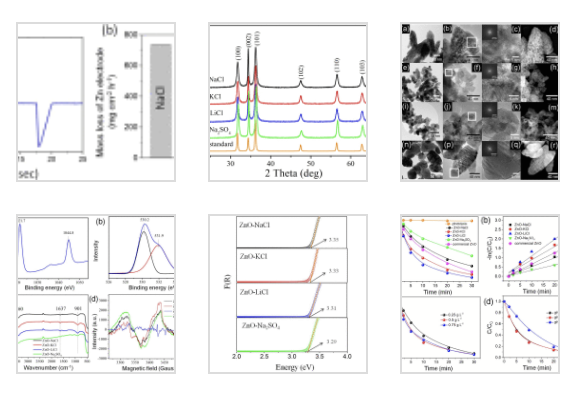Ciprofloxacin (CIP) is a broad spectrum synthetic antibiotic of the fluoroquinolone group frequently detected in hospital wastewater, sewage treatment plant effluent, and surface water. The current study investigates the CIP photocatalytic degradation at nano-ZnO synthesized by a novel large-scale and environmentally friendly electrochemical method using pulse alternating current. This method implies the use of LiCl, KCl, NaCl and Na2SO4 as the electrolytes without adding any organic additives or post annealing. The effect of electrolytic media on the morphological, structural, optical and electronic properties of the resulting nano-ZnO was evaluated. The highest CIP removal efficiency reached 93.6 % in 30 min and the TOC removal efficiency reached 51.0 % in 60 min under optimal conditions (5 mg L−1 initial CIP concentration, pH 6.5, catalyst dosage 0.5 g L−1, UV light intensity 2.0 mW cm−2) in the presence of ZnO nanoparticles prepared in LiCl. The efficiency values are higher than those of commercial ZnO due to the increased surface area and the improved separation of charge carriers. Reactive species study confirmed the main role of h+ in the photodegradation process. The photocatalytic performance of the synthesized ZnO samples suggests that these materials can be used for water treatment in environmental applications.

Ciprofloxacin (CIP) is a broad spectrum synthetic antibiotic of the fluoroquinolone group frequently detected in hospital wastewater, sewage treatment plant effluent, and surface water. The current study investigates the CIP photocatalytic degradation at nano-ZnO synthesized by a novel large-scale and environmentally friendly electrochemical method using pulse alternating current. This method implies the use of LiCl, KCl, NaCl and Na2SO4 as the electrolytes without adding any organic additives or post annealing. The effect of electrolytic media on the morphological, structural, optical and electronic properties of the resulting nano-ZnO was evaluated. The highest CIP removal efficiency reached 93.6 % in 30 min and the TOC removal efficiency reached 51.0 % in 60 min under optimal conditions (5 mg L−1 initial CIP concentration, pH 6.5, catalyst dosage 0.5 g L−1, UV light intensity 2.0 mW cm−2) in the presence of ZnO nanoparticles prepared in LiCl. The efficiency values are higher than those of commercial ZnO due to the increased surface area and the improved separation of charge carriers. Reactive species study confirmed the main role of h+ in the photodegradation process. The photocatalytic performance of the synthesized ZnO samples suggests that these materials can be used for water treatment in environmental applications.
